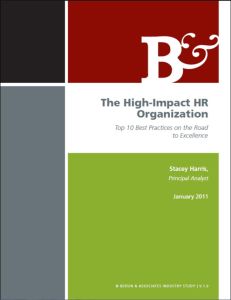
The High-Impact HR Organization
Top 10 Best Practices on the Road to Excellence
Recommendation
Human resources professionals may be used to a lack of in-house popularity, but the more serious issue is whether they have an influential voice in the boardroom. As managers of a firm’s most critical asset – “its talent” – that voice is imperative. To earn it, HR must become “high impact.” Using well documented research, this Bersin & Associates report details 10 important practices HR professionals can use to move beyond basic personnel functions and chart a path to providing “strategic HR.” Under the leadership of former senior analyst Stacey Harris, Bersin surveyed more than 700 companies and conducted detailed interviews with 50 representatives of different firms from diverse sectors, including health care, retail, banking, and education. The result: a highly applicable guide that getAbstract recommends to HR professionals who want a seat at the corporate table, not just for their own careers, but for the good of the company and everyone in it.
Summary
About the Author
Stacey Harris spearheaded Bersin & Associates’ human resources division and led research projects on HR-related topics. She is now vice president of research and advisory services for the Brandon Hall Group in Cleveland, Ohio.
Learners who read this summary also read
Related Skills























Comment on this summary